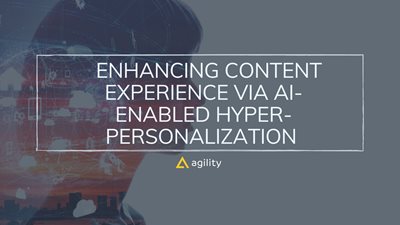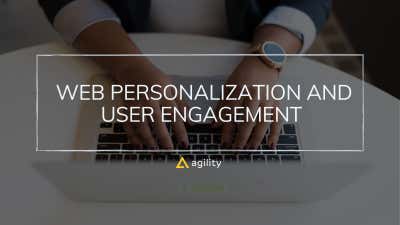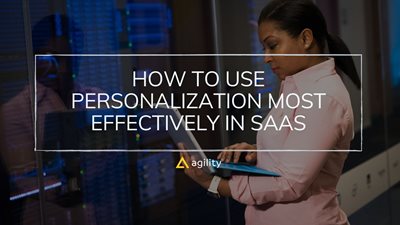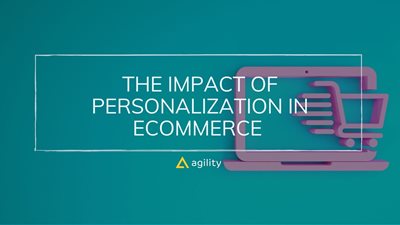Enhancing Content Experience via AI-Enabled Hyper-Personalization

Maintaining customer engagement is a real concern for businesses. For many, the job ends once they convert the leads into sales. Yet, the success of the company also depends on return customers. That is why marketing strategies like producing high-quality content are critical. The ability to relate with customers ensures that they will never leave.
Look at the following statistics. 82% of marketers have content marketing strategies and are utilizing them. Only 10% do not use content marketing. 67% of marketers agree that content marketing is critical in demand lead generation. 72% depend on content for educating customers. 63% believe that content marketing helps build loyalty with existing customers.
It is important to note that the scope of content marketing has expanded. It is no longer about creating blogs or video content. Then you sit back, hoping that audiences will interact with it. Marketers are now employing the use of interactive content to increase engagement. The ability to keep audiences on their website longer is ideal for data collection.
Now there is the application of downloadables, carousels, digital tools, and polls. Such content is interesting. It ensures website visitors stay on the website a little bit longer.
AI hyper-personalization is also increasing the effectiveness of interactive content marketing.
Our article looks at enhancing content experiences via AI-enabled hyper-personalization. Let's see what we can uncover with this interesting topic.
Understanding Content Experience
Content experience is the total experience of consuming, accessing, engaging, and responding to brand content.
You will find the content on different platforms, devices, and channels. Content experience must accompany a customer from the first interaction with the brand. And it continues along the sales funnel to the end and after.
Some key features of content experience include:
- High levels of relevance
- Personalization
- Timeliness
- Convenience
- Consistency
Content Experience vs Content Marketing
So, how is the content experience different from content marketing? Well, content marketing is a blanket description. It covers the creation, distribution, and analysis of content marketing.
The content experience takes a more holistic approach. Remember, it accompanies a prospect along the sales channel to final conversion. At every stage, potential customers need resources to inform their thinking. So, think about it this way.
- At the top of the funnel is the awareness or discovery stage. Any content you have should inform and educate. Webinars, videos, tips/advice, and blog posts are examples.
- The Middle of the funnel or consideration stage. The customer is considering whether to buy from you. So, case studies, how-to-tutorials, product descriptions, testimonials, and FAQs will be ideal.
- The bottom of the funnel is the conversion stage. At this point, you will have achieved the goal of creating interest and the prospects' desire to buy. Demos, success stories, and interactive assets work well here.
One critical strategy in content experience is demand generation. The idea is to create demand, interest, and awareness of your offering. The teams work to ensure customers engage with the brand and its products or services.
Demand marketing ensures:
- Proper targeting of your services or products
- Better positioning of a company in the market
- Prospect movement along the sales and marketing funnel, etc.
Also, it would help if you remembered each customer is unique. So simple segmentation (which we will discuss in detail below) may not work. AI-enabled hyper-personalization is the answer. This is because it depends on data to let you know what each customer needs/wants.
Understanding Hyper-Personalization
Hyper-personalization is a relatively new concept in marketing. It incorporates the use of artificial intelligence and real-time data. All with the aim of displaying curated content and products to shoppers.
The strength of hyper-personalization is its ability to treat customers as unique individuals. Indeed you tailor messaging and product discovery journeys to a granular level. All the time, taking into consideration the customers' wants and needs. That requires understanding their unique tastes and preferences. With clarity, providing unique shopping experiences for each customer becomes easier.
Take a look at the definition of hyper-personalization above. The difference with traditional personalization becomes quite clear. With the latter, marketers would use generic messaging to recommend products.
But with AI technologies, you can provide a more sensitive, context-based experience. All while taking into account how the customers interact with the brand.
Also, by now, you can see that data is critical for getting an overview of customer needs and behaviors. This becomes the basis for content development. You must ensure that it reaches all the touchpoints along the customer journey.
Hyper-personalization is a long-term strategy. That brings to the fore the important role of AI. Such innovations have the ability to adapt to ever-changing customer preferences.
Machine learning, a subset of AI, looks at past shopping behavioral patterns. It then uses predictive analytics to determine what a specific customer would want.
How Hyper-Personalization Works
To understand how AI hyper-personalization can enhance the content experience, we need to know how it works. We can summarize it as follows:-
-
The Use of Historical Data
Machine learning uses historical data to learn customer behavior. As we have mentioned several times above, each customer's unique. The motivation to buy from one company will be different from another. The same applies to their content experience with the brand.
Let's use the definition of content experience above for a minute. Each customer consumes, accesses, engages and responds to content in a unique way.
Machine learning technologies can pick up these unique nuances. These are important for more significant insights into customer buying behavior. And the brand can use the same for current and future decisions.
-
Continuous Feedback From AI Self-Learning
Another strength of AI self-learning lies in the feedback loop. You get continuous feedback for every decision the AI system makes. That way, you can identify any anomalies and correct them. Such functionality provides fantastic insights for the marketing teams. All these are critical for content generation.
You can also use AI data analysis for content generation. It can show which topics or subjects will increase customer engagement. The tools can also recommend content that will enhance the customer experience.
AI-Enabled Hyper-Personalization in Content Experience
For a long time, marketers would push product or service information to customers. Take the example of analog advertising. They would buy media space, put up an ad, and hope the right people see it.
But there is a challenge with such advertising strategies in the modern world. The contemporary consumer has got so many choices. The number of brands trying to sell their products is quite vast. That means the amount of information coming at customers is quite significant.
Depending on analog marketing tactics that use hard sell language, product pushing messaging can no longer apply. It helps to communicate with customers in a way that does not make it feel that all you are interested in is pushing product information. The trick lies in creating a content experience at every touchpoint.
Unveiling Challenges of Creating Content Experiences
Marketing 101 insists on the importance of audience segmentation. Indeed, it is a critical component in any processes or strategy development. It helps avoid the one-fits-all or mass marketing methodologies. With segmentation, you put groups of people who share specific characteristics.
So let's say you are targeting parents between the ages of 25 to 35. The assumption for the marketing team is that the groups are homogeneous in nature. That means within each segment are individuals who share specific characteristics. Now, that in itself is not a bad idea.
But, the shortcoming of segmentation presents with a deeper exploration of each group. It is not uncommon to find huge differences right within. Some parents may be in higher economic strata than others. The same applies to education, marital status, consumption patterns, etc.
So, you may find that your brand's content experience strategy is not working as you thought it would. Indeed you may be resorting to the one-fits-all but within the groups. Yet, remember, this was a considerable concern with segmentation as the primary marketing tool.
Now, let's say you're creating content for your marketing campaigns. You do so, assuming everyone in the segment will engage with the content due to their similarities. Yet, that may not be the case if you don't consider each individual's wants and needs.
Consider the example of a parent falling in the 25-35 age demographic. Yet they have economic means and may not have any interest in promos or discounts. Thus, tactics like creating urgency will not work.
The same applies to parents within the demographic who have high levels of education. Content marketing that would resonate includes research papers, white papers, and case studies. Yet, other parents without the same level of education would appreciate tutorials. They may also want to learn through educational material.
But the reality is that lack of personal data is a major stumbling block. Or at least it was until AI-enabled hyper-personalization became a reality. With AI, it is easy to sieve through tons of data to get insights. That can help with creating relevant content based on individual needs.
So are we saying we need to throw out the vital role of segmentation? The answer is no. It is essential to have a series of groups with your target customers. It makes it easier to mine or filter data with clear categories.
Remember, you will need to fill in relevant data into the AI software. That is a critical step for the development of algorithms. Clear categories based on demographic, psychographics, and behavioral profiles will be helpful.
How AI-Enabled Hyper-Personalization Can Enhance the Content Experience
We have already talked about the challenges of interacting with modern customers. There is a lot of information, which means a lot of choices.
The modern customer is also very demanding and expects a lot from brands. It is no longer only about selling products or services. Customers want to feel appreciated and valued by the companies they transact with. And it gets better if you tailor the personalization to suit individual needs.
Look at the statistics below.
- 80% of customers will likely buy from brands that provide tailored experiences.
- 72% will only engage with messaging that contains a level of personalization.
- 66% of customers expect brands to understand specific or individual needs.
- 70% base their loyalty on how well the brands understand their individual needs.
The reality is that it is so easy to lose customer trust nowadays. Mass marketing and macro segmentation are no longer applicable. The same applies to simple personalization. It takes much more than an email bearing the customer's name to get loyalty.
AI hyper-personalization for content experiences takes personalization a notch higher. It utilizes real-time and behavioral data as the basis for the creation of communication. The communication must be contextual and relevant to the end user.
The emergence of so many channels or touch points for customers is another area of concern. This has led to the concept of multi-channel marketing. But, you must complement multi-channel marketing with omnichannel marketing. If not, you lose out on critical customer engagement. The former focuses on using as many avenues as possible to reach customers.
Omni-channel marketing is customer-centric. It requires providing a unified, not siloed, experience across the different channels. The user experience must be seamless, even if they switch from platform to platform. And even then, you must remember that each customer is unique and has unique needs and wants. And the only way to know this is with AI-enabled hyper-personalization.
Final Thoughts
We have looked at how AI-enabled hyper-personalization can enhance content experience. While segmentation and personalization are critical, there is more to marketing.
Marketing is all about creating interest and demand for your products. And content generation and content experience are critical aspects. How each customer interacts with the brand at every touchpoint is critical. As a brand, the key consideration is to ensure the interactions are seamless. Whatever resources or information you provide should be relevant. Also, you cannot have blanket communication as each customer is unique. And for this, you need data insights specific to the customer.
AI-enabled hyper-personalization uses data to inform decision-making. Machine learning looks at past patterns or buying behaviors. From this, it can derive critical insights for current and future marketing strategies.



